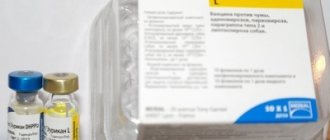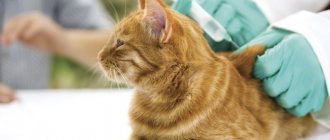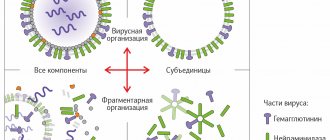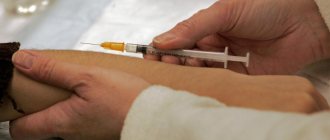Toy Terrier. What vaccinations are needed?
Veterinarians divide vaccinations into mandatory and optional.
Mandatory vaccinations for a toy terrier.
Mandatory - vaccines against dangerous diseases that lead to death.
- rabies. This disease is dangerous for both dogs and humans. The main danger is that at the moment, once clinical symptoms appear, there are no effective treatments. So after this, think about whether that terrier needs to be vaccinated against rabies or not.
- bordetellosis. The infection, entering the dog’s body, causes inflammation of the respiratory system (lungs, trachea and bronchi).
- plague. One of the most common and highly contagious diseases. The highest percentage of deaths among young dogs is caused by plague.
- viral hepatitis. The risk group includes young animals. Therapy is carried out through the administration of allergenic serum.
- adenovirus infection. An infection not detected in a timely manner or an advanced stage leads to the development of acute forms of the disease.
- parvovirus enteritis . The causative agent of parvovirus is characterized by high resistance to any influence, even physical and chemical. The virus is dangerous because it can remain active in the environment for several months.
- leptospirosis (infectious jaundice). Leptospira microbes affect the circulatory system and internal organs of the dog. It is also dangerous for humans.
Additional vaccinations (optional vaccinations).
Not all toy terriers need additional vaccinations. The veterinarian will develop an individual vaccination plan for your dog, depending on the developed immunity and the general condition of the animal’s body.
Optional vaccines include vaccinations against the following diseases:
- piroplasmor. This disease is caused by the bite of a forest tick. This disease is common in European countries.
- tick-borne borreliosis (Lyme disease), the causative agent of which is also a tick.
- fungal diseases.
- canine parainfluenza is dangerous for toy terrier puppies because it is transmitted by airborne droplets.
- coronavirus enteritis. A pet can catch the disease by sniffing the feces of an infected pet or through direct contact with a sick dog.
The cost of health, if we consider vaccinations for a toy terrier, is influenced by such factors as the vaccine manufacturer and the place of vaccination of the toy terrier. The price of vaccination ranges from 150 to 400 hryvnia. If the price is higher, then the price may also include entering information about the vaccine into the veterinary passport of the toy terrier.
Can a vaccine be harmful?
With the help of a vaccine, a virus is introduced into the animal’s body, which has been weakened or killed by special manipulations. To develop immunity, the puppy must have a lot of strength and no health problems. Otherwise, it will be difficult for the defense mechanism to overcome hostile bodies, and the baby may become infected with the drug for which he was injected.
To prevent such cases, it is prohibited to vaccinate:
- weakened and sick dogs;
- puppies that have been in contact with presumably sick animals;
- medications that have expired or whose storage and transportation conditions have been violated: under direct sunlight, in conditions of high temperature or humidity;
- if there is a possibility that the kitten is infected;
- if less than 2 weeks have passed since antibiotic therapy;
- before and after any surgical interventions.
If you suspect that your pet has any disease, including the one against which vaccination is being carried out, it is necessary to submit urine and blood for testing. Their result will make it possible to verify the absence or presence of the virus in the baby, even if there are no characteristic manifestations of infection.
When should a toy terrier get his first vaccination?
Caring for the health of a decorative dog puppy begins literally from the first minutes of its birth. Vaccination of Toy Terrier puppies begins at the age of 3-5 weeks, depending on the vital signs of the body and the type of vaccination.
The fact is that currently there is an excellent selection of vaccines for dogs, which consists of mono-vaccines aimed at developing immunity against one disease, and complex vaccines consisting of antigens of several diseases.
The greatest convenience is manifested in the use of complex vaccinations for toy terrier puppies. The most common infectious antigens are included in one preparation. Complex vaccination causes the body to develop immunity against rabies, parvovirus enteritis, canine distemper, rhinotracheitis, leptospirosis and adenoviral hepatitis.
Your right to choose a live or killed vaccine. If the first consists of pathogens that were grown in laboratory conditions, then the second is filled with completely neutralized dead microorganisms. It is worth drawing your attention to the following difference between these types of vaccines. Strains of live antigens introduced to the terrier provoke diseases in the dog, but in a very mild form, and dead pathogens do not entail any deviations in the post-vaccination period. But it is live strains that provide more lasting immunity.
The quantitative content of pathogens in a complex vaccination also plays a role. The higher the number of antigens in the vaccine, the stronger the manifestation of disease symptoms in the animal, but at the same time, the higher the formation of high immunity in the dog.
The first vaccination for a toy terrier puppy does not protect against diseases, since it is given against infectious diseases called “kennel cough” - bordetellosis and canine parainfluenza. The drug is administered when the puppy is 4-6 weeks old.
This is followed by quarantine for two weeks, after which the decorative dog is given a second vaccination. Please note that you should buy a puppy only after the second vaccination and subsequent quarantine. If a breeder offers you a dog with one vaccination, then no matter how much you would like to quickly cuddle a little bundle of happiness, give up this idea - wait. After all, in the event of any disease, you may not be able to cope with the disease or not respond to the symptoms that appear in a timely manner. Remember - the first two vaccinations are done by the breeder.
Features of vaccinations
- Vaccinations can only be given to completely healthy puppies, so a week before vaccination you should carefully monitor their behavior and condition.
- 2-3 weeks before the vaccine is administered, it is necessary to deworm the dog with a drug recommended by the veterinarian. Otherwise, parasites (if any) can negatively affect the formation of the immune response.
- For a week after immunization, it is recommended to observe a quarantine regime: limit the dog’s contact with other animals and strangers, do not overtire it or bathe it, provide adequate nutrition and normal sleep, and do not walk in places where other animals are freely walking.
It is necessary to understand that a vaccine is not a cure; it is not able to help a sick dog, therefore it is necessary to adhere to the recommended vaccination schedule according to age.
When should a toy terrier be vaccinated?
In order not to doubt or worry about when to vaccinate your toy terrier, we offer you a classic schedule of vaccinations for your toy terrier.
| Dog age | Vaccination | |||
| Complex vaccine (canine distemper, adenoviral hepatitis, respiratory adenovirus, parvovirus enteritis, parainfluenza) | Leptospirosis | “Kennel cough” (parainfluenza, bordetellosis) | Rabies | |
| 4-6 weeks | + | + | ||
| 8-9 weeks | + | + | ||
| 12 weeks | + | + | + | |
| 1 year | + | + | + | + |
| 2 years | + | + | ||
| 3 years | + | + | ||
| 4 years | + | + | + | + |
| 5 years | + | + | ||
| 6 years | + | + | ||
| 7 years | + | + | + | + |
| 8 years | + | + | ||
| 9 years | + | + | ||
| 10 years | + | + | + | + |
| 11 years | + | + | ||
| 12 years | + | + |
There are several rules associated with vaccinations for miniature terriers, including Russian toy terriers, which you, as the owner, must follow:
- Before introducing the antigen into the dog’s body, prepare the animal. Cleanse your pet's body of helminths that reduce the protective function of the toy terrier's body. Get rid of fleas and ticks, if present. A couple of days before the vaccination procedure itself, monitor the toy’s body temperature. The norm is a temperature from 37.5 to 39 degrees.
- If the dog is unwell, notify the veterinarian so that he can reschedule the procedure.
- Observe your pet for the first two hours after vaccination to ensure that he does not have an allergic reaction to the drug.
- During the quarantine period (two weeks after vaccination), reduce or completely eliminate contact with other dogs. Follow all the rules for caring for your pet, especially regarding hygiene. Do not allow the animal to overheat or hypothermia, do not bathe it, do not change its diet, or give it great physical activity.
- any changes in behavior during this period should be the reason for an early visit to the veterinarian.
After fourteen days, the terrier’s immunity will be formed and you can rest assured about your friend.
Preparing the puppy for vaccination correctly
Preparing your pet for immunization should begin 12-15 days in advance. What to do:
- treat once against blood-sucking parasites: ticks, fleas - 10 days before vaccination;
- treat for worms; if there is infestation with helminths, then twice, if not, then once; the procedure is also carried out 10 days before the injection;
- exclude excessive physical activity, stress, overwork; this requires a 3-week period before vaccination.
On the day of the manipulation, it is recommended to stop feeding the puppy. If your veterinarian visit is scheduled for the evening, you can feed him a small amount of dry or regular low-calorie food.
It is mandatory to carry out anthelmintic and antiparasitic measures before any vaccination of not only cubs, but also older dogs.
Why is vaccination necessary?
A dog, unlike a cat, is constantly in contact with the environment, with other dogs, this is associated with walks. It is during this time spent on the street that a dog can “catch” a dangerous virus, which will lead not only to illness, but also to death.
It is important to remember that an unvaccinated dog potentially poses a danger to humans, since a large number of diseases are transmitted from animals to humans, for example, the incurable disease rabies.
A vaccinated pet has immunity, which means it cannot become infected or infect others.
Origin of the breed
The breed was very popular among the European aristocracy in the late 19th and early 20th centuries. Miniature English Toy Terriers were bred in Great Britain by crossing dogs of decorative and hunting breeds.
Manchester terriers, small English greyhounds and Italian greyhounds left their mark on the pedigree of toy terriers. Initially bred for hunting small burrowing animals, the breed soon began to be considered decorative, “sofa”. It was customary to have such dogs in noble houses, carry them with you, and take them on trips. From Europe, the “travelers” reached Russia, where difficult times awaited the breed at the beginning of the last century.
The October Revolution changed the mentality of the people. And everything that was previously considered aristocratic, “lordly” was stigmatized and quickly forgotten. Dogs with a characteristic noble reputation did not fit into the new ideology of society. From the 20s to the 50s, no breeding work was carried out with the breed at all. The situation changed only in 1956, when Soviet cynologists announced the start of work on breeding “our” Russian Toy Terrier breed.
Already in the late 50s, the first smooth-haired representatives of the breed were bred, very similar in appearance and character to their British counterparts. They called them Russian Toy Terriers. Just two years later, breeders introduced long-haired dogs called Moscow Toy Terriers. Since then, breeding work has not stopped.
from the personal archive / Olga Moskaleva
In the mid-90s, the first national breed club appeared in Moscow, and a year later the first exhibition was held. But the results of the work of Soviet breeders were not recognized internationally for a long time. The standards recognized by the Fédération Cynologique Internationale turned out to be different from the description of the Toy Terrier breed bred by Soviet breeders. It was only in 2006 that the breed received conditional recognition from the international community. But it was renamed: the word terrier disappeared from the name, since experts agreed that these dogs had nothing in common with terriers. And Russian and Moscow Toy terriers were combined into one standard - Russian Toy, which applies to smooth-haired and long-haired representatives.
Russian Toys received final recognition in 2021, and today breeders have the right to represent their pets at the Fédération Cynologique Internationale championships.










